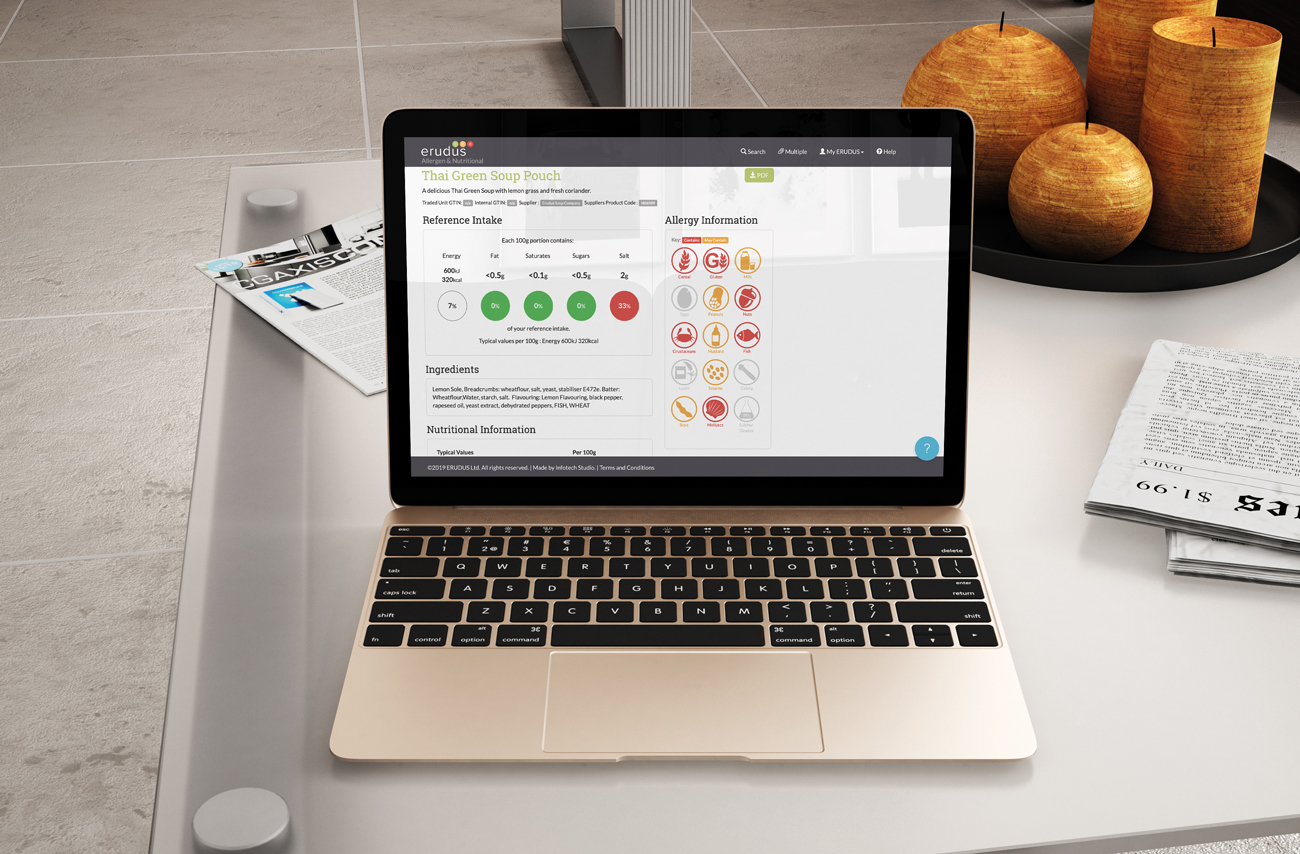One of the biggest issues facing the wholesale channel over recent years has been the struggle for a central food allergen database. Paul Hill investigates the current state of play and what needs to be done

Following the tragic death of Natasha Ednan-Laperouse, the teenager who died after
suffering an allergic reaction to a Pret a Manger baguette in 2016, the government has announced it will introduce legislation that will require food businesses to include full ingredients labelling on pre-packaged foods prepared on site.
Currently, food prepared on the premises in which it is sold is not required to display allergen information in writing, meaning the UK’s two million allergy sufferers cannot be absolutely sure they are safe.
“This is why Natasha’s Law has been introduced, which comes into effect in October 2021,” explains Coral Rose, managing director of The Country Range Group and chairman of the Federation of Wholesale Distributors (FWD). “This will extend labelling requirements for people with food allergies and intolerances. The new law will mean food businesses will be required to provide full ingredient and allergen information on foods that are pre-packed for direct sale.”
However, the wholesale sector is looking for this to go further, with the FWD calling on the government to introduce a central food allergen database for all food-product attributes, which wholesalers can access to ensure they can flag any potential allergens to their customers, and then to consumers. “We’re asking that the government makes it a legal requirement for manufacturers and suppliers to take responsibility for ensuring this information is comprehensive, accurate and up to date,” says James Bielby, chief executive of the FWD.
“We strongly believe the government should explore such a database, and this system would be fundamental to ensuring the changes to allergen labelling are robust and reliable. We are working with the FSA and Defra to call for this mandated centralised product database,” he adds, before stating that such a system would be straightforward and easy to implement because suppliers are already providing information to customers – just not in one specific location. “Suppliers would only be required to provide information once, saving them time and money,” he says.
Colin Smith, chief executive of the Scottish Wholesale Association (SWA), echoes these thoughts. “It’s a challenging area of legislation,” he says, “but having a mandatory national database will reduce costs, save time and mean that everyone is taking the same information from the same place, reducing the chance of misinformation. It’s all about protecting the public.”
Scotland already has an online menu calculator called MenuCal, a free tool for food businesses to provide information about the calories and allergens in their dishes to help customers make informed choices. “However, while this is a step in the right direction, it is quite generic, and businesses still have to check information on packaging,” he says. “A central allergens database for all food-product ingredients that wholesalers can access makes sense and would enable wholesalers to relay information to customers more easily.”

If this central system is to come to fruition, software business Erudus has the tools and framework already in place to achieve this, and is working with more than 120 wholesalers and buying groups around the UK, including Brakes, Bidfood, The Country Range Group, Fairway Foodservice and Caterforce.
“We use Erudus in the absence of a government-endorsed database,” explains the latter’s managing director, Gary Mullineux. “Erudus fills the gap. It is a great tool, and provides us with a way to communicate data to our customers, but it’s only as good as the information
we put in.
“Our technical team regularly checks the information for our own-brand products to ensure it is accurate and up to date, and we take full responsibility for ensuring the allergen information is accurate.”
Describing how the software works, Erudus chief operating officer Jon Shayler says: “At the top level, we offer access to data – legally required allergen, nutrition and technical data via a number of software solutions. To go a bit deeper, from the front end – so to speak – we have a range of our own features and solutions that make it as easy to use and get the most from the data.”
These features include not only the Erudus portal itself, but also applications such as Query Builder and Recipe Builder, which make life easier for wholesalers and caterers when it comes to identifying the allergen information in food products and recipes.
“One of the most important things we offer wholesalers is our ear,” adds Shayler. “It’s one of our core values that we listen to our users and develop the platform based on their requirements.
“Not only do we encourage users to contact us and feedback, but we also have dedicated Slack channels open for direct access to the relevant teams in the business.”
 Challenges
Challenges
However, with the bottom line at the forefront of wholesalers minds, it can prove difficult to convince them of the need and value of a central system. “It’s essentially a ‘chicken-and-egg’ scenario – the wholesalers won’t engage in a central depository unless all the product data they need from the manufacturers is there.
“In turn, manufacturers won’t engage and put their product data onto a central depository system unless there is enough demand from the wholesalers to do so,” explains Shayler.
“Another huge challenge is the sheer scale that would be required for a central depository system to work,” he adds. “In this industry, there’s no one-size-fits-all, and it would have to be accessible to both big businesses and small kitchens alike.”
The question of whether the government has the appetite or the resources to undertake the task is another major sticking point. “They would have to take on the management of such a venture, and is there the time, money and resources there for that in the current climate?” asks Shayler.
“Now, if the industry were to unite on the matter, we wouldn’t even need a government mandate and could self-govern instead, which would present its own challenges, but not on the same scale as if the government were to take on the venture.”
Chris Binge, chief executive of Fairway Foodservice, believes that interested parties need to agree on data fields. “Is it just 14 allergens and nutrition? Or should it be packaging waste data, too? Or should it cover more data? If the government has the appetite to mandate all food manufacturers to deposit data, it is possible that Erudus could work with them.”
 Responsibilities
Responsibilities
“Certainly, manufacturers need to take their responsibility to provide the product information electronically more seriously, and not revert to the ‘it’s on the label’ argument, so I think legislation would be welcomed by wholesale and caterers,” Binge adds.
Bielby also believes that suppliers should take responsibility for communicating the ingredients of their products and any allergen risks. “Manufacturers often reformulate their products, but the ingredient change may potentially not be accurately fed through the supply chain to consumers. This is particularly dangerous if the new formulation includes allergens, such as changing vegetable oil to rapeseed oil or including mustard seed in mayonnaise.”
He adds that it’s unfair, unsafe and unrealistic to expect operators and wholesalers to bear the burden of giving accurate advice to consumers without the assurance of reliable data from their suppliers. “A system needs to be created whereby a seller can quickly check the allergens in their products. This would be updated in real time and have an alert system via the product code automatically flagging the change, so it can be seen at point of purchase if a recipe is changed.”
Rose adds: “It’s vital that changes are made to the current system as caterers look to their wholesalers to provide the allergen information on the range of products they buy.
“Currently, suppliers are not obligated to provide this information, so the onus is on the wholesaler to obtain this information from suppliers and collate the information in an easy-to-access format for caterers.”
She adds that not all suppliers are engaged with this and those that are may not be proficient at keeping their information up to date. “In the absence of a central database, suppliers are being requested to complete numerous systems for individual wholesalers and users, which requires a massive amount of effort on their part and is time-consuming,” she says.
Binge, meanwhile, is of the opinion that the wholesale industry needs to unite and put pressure on manufacturers to make their product information available electronically. “It is in all of our interests to have this information freely available,” he says.
“Even if the government can’t – or won’t – act, we have the buying power as a collective to make manufacturers supply the data and keep it current.
“Many manufacturers still don’t see the need to use it to provide current data electronically.”
Being the only part of the supply chain that links suppliers with caterers, the wholesale industry is in a privileged position in which it holds the key to unlocking the potential central depository and creating something good for society.
Whether wholesalers unite as one and take the plunge is another question.










“It’s on the label” isn’t an argument, it’s the legal requirement and the only accurate source of allergen data that caterers should rely on. It’s not rocket science.